Authentic assessment for English language learners written and narrated by Dr. Mohammad Hossein Hariri Asl on how to assess student’s competency and proficiency in second language learning
Author: Dr. Mohammad Hossein Hariri Asl
Video of authentic assessment for English learners
Abstract
On account of an overemphasis placed upon traditional assessment in language teaching, the testing administrators constantly belabor the point of final and entrance examinations as an ultimate litmus test for learners’ competency. Hence, intensive cramming in the form of memorization and parrot-learning peremptorily dominates an extensive bona fide understanding of the materials. In fact, the victimization of the lengthy process at the cost of the transient product reaches its pinnacle; consequently, the phenomenon of student alienation comes into being. To investigate the study, a qualitative approach based on triangulation (i.e. observations, interviews, and documentations) was taken. The employment of this qualitative methodology was due to the fact that a naturalistic grounded theory research design mixed with Classroom-centered Research (CCR) was regarded as the finest procedure to collect and analyze the data over an extended period of time around 3 months in length. The findings reveal the significance of an amalgamation of product and process-oriented approaches so that the learners are evaluated on what they integrate or produce rather than on what they are able to recall or reproduce. The main goal of alternative assessment is to gather evidence about how learners are approaching, processing, and completing real-life tasks in a particular domain, that is, to forge a strong link between what happens in the classroom and what occurs outside the class. By dint of self, peer, and portfolio assessment in language schools, institutes, and universities, detailed information on the strengths and weaknesses of each individual student is furnished; therefore, retrospective teaching or learning is objectified. Moreover, the number of the raters is multiplied by the total number of the learners; hence, there will be less discrimination and subjectivity in assessment. Furthermore, depending on developed metacognitive knowledge and strategies, the learners will grow additional independency, autonomy, and intrinsic motivation in language learning.
Introduction

In today’s education, assessment is one of the indispensable features of the curriculum. As Richards and Schmidt (2002) have stated, assessment is “a systematic approach to collecting information and making inferences about the ability of a student or the quality or success of a teaching course on the basis of various sources of evidence” (p. 35).
In consideration of the above definition, although the goal of assessment is invariably the same over the passage of time, its modus operandi is subject to informed modifications in response to newly developed requisites.
As a consequence, two distinct versions of assessment come into existence, i.e. Traditional Assessment vs. Authentic or Alternative Assessment. As it is self-evident, the traditional version of assessment cannot function well enough to satisfy the requirements of today’s education. As a result, employing authentic assessment with its exclusive characteristics is an enlightened choice to make.
Authentic or alternative assessment refers to a particular type of appraisal in which it is strongly attempted to bridge the gap between curriculum and real-life situations. The other benefit derived from authentic assessment lies in the maximization of interpersonal interactions between the teacher and the learners.
As Huerta-Mactas (1995, as cited in Richards & Renandya, 2002) maintains, “Alternative assessment is different from traditional testing in that it actually asks students to show what they can do. Students are evaluated on what they integrate and produce rather than on what they are able to recall or reproduce” (p. 339). The main goal of alternative assessment is to gather evidence about how students are approaching, processing, and completing real-life tasks in a particular domain.
Huerta-Mactas (1995, as cited in Richards & Renandya, 2002) outlines the characteristics of alternative assessment as below:
Alternative assessment provides alternatives to traditional testing in that it (a) does not intrude in regular classroom activities; (b) reflects the curriculum that is actually being implemented in the classroom; (c) provides information on the strengths and weaknesses of each individual student; (d) provides multiple indices that can be used to gauge student progress; and (e) is more multi-culturally sensitive and free of norm, linguistic, and cultural biases found in traditional testing. (p. 339).
Statement of the problem
These days, the employment of authentic assessment seems to be categorically urgent inasmuch as the fact that regrettably as long as SLT is concerned, merely a traditional dimension of assessment is taken into account. More specifically speaking, the devastating blows of traditional assessment are utterly lucid and apprehensible to all of us, e.g., when the poor learners are obliged to put up with the ponderous and futile task of memorizing the materials like a parrot without understanding them in depth.
Another demerit attributed to traditional assessment is an abundant emphasis that is placed upon final exams. To be more exact, according to many present educational programs, the extensive process must constantly be victimized at the expense of the ephemeral product. As a consequence, we belabor the application of final exams.
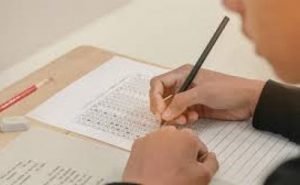
To add insult to injury, we tenaciously and blindly cling to entrance exams and over-exaggerate their saliencies as the ultimate acid test to assess the learners’ competency. The detrimental repercussion of so doing is that irrespective of how the learners have participated in the course from the outset so far, and what sort of procedure they have employed, their aptitude and competency are determined merely through some perfunctory and superficial questions.
What’s worse, the majority of the questions are multiple-choice ones in which the participants are forced to depend solely on their receptive knowledge. That is to say, they are deprived of their obvious right, i.e. to make use of their productive competency. That’s why a vast array of the learners, intentionally or unintentionally, overlook the process of learning and postpone it until the last time by resorting to cramming and stick to a couple of hours as the entrance exam.
Regarding this issue from another angle, by overemphasizing traditional assessment with its mechanical nature and devastating impact on education, the learners are precluded from developing an active share and role in response to their course. It means that language classes go fundamentally unilateral and it becomes infinitely elusive to locate the traces of bilateralism.
It is due to the fact that learners are alienated from the course and the teacher. They just take the course and resort to any scheme to pass it even by cheating. In this regard, since the process is not valued at all, they fail to grow intrinsic or integrative motivation. Instead, they develop extrinsic and instrumental motivation.
Purpose of the study
This study is basically oriented towards the aim of intrinsically motivating the learners so that they reduce their dependency upon their teachers. This hypothesis is postulated that a change of emphasis from a solely product-oriented approach to a confluence of both product and process-oriented approaches can raise the learners’ spirits to give more credit to the lengthy process of education. In other words, the learners are not alienated from their own classes because, every so often, they are encouraged to develop their best to the course. That’s why they gradually engender a sense of belongingness to the class.
On the other hand, by dint of authentic or alternative assessment, the learners are involved in real-life situations. In so doing, when they notice that they can contribute their learning in the class to their actual lives outside the class, they unwittingly develop and maintain a lot of inducement to make the most of their learning.
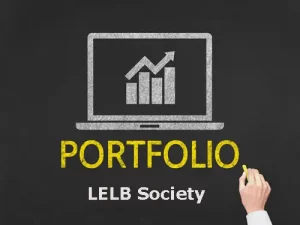
Regarding this issue from another perspective, in the light of portfolio assessment, which is an inseparable dimension of authentic assessment, the learners are urged to keep a diary of their progress in language learning. This action per se requires a plethora of retrospection, metacognition, and rumination. As a result, the learners gradually acquire an amount of autonomy and individualization that is pretty conducive to language learning.
Literature review
The term assessment refers to a variety of ways of collecting information on a learner’s language ability or achievement. Although testing and assessment are often used interchangeably, the latter is an umbrella term encompassing measurement instruments administrated on a one-off basis such as tests, as well as qualitative methods of monitoring and recording student learning such as observation, simulations or project work.
At first glance, a clear line of distinction must be made between assessment and testing. In fact, these two terms are not synonymous. As Brown (2004) has noted, “Tests are prepared administrative procedures that occur at identifiable times in a curriculum when learners muster all their faculties to offer peak performance, knowing that their responses are being measured and evaluated” (p. 4).
He (2004) further adds that assessment, by contrast, is an ongoing process that encompasses a much wider domain. As a matter of fact, testing occurs when the learners are fully conscious of measurement, whereas in assessment the learners are subconsciously evaluated.
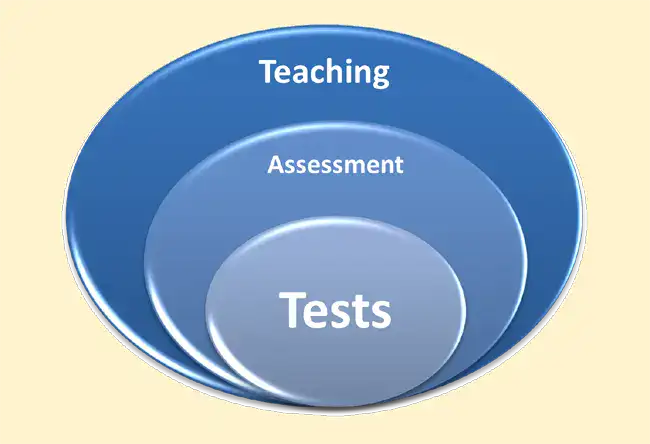
Brindley (1989) states, “Assessment is also distinguished from evaluation which is concerned with the overall language program and not just with what individual students have learnt” (p. 137).
The term assessment per se is divided into several categories with reference to the objectives it is intended to achieve. For instance, as Hughes (2003) has stated, assessment of achievement aims to establish what a student has learned in relation to a particular course or curriculum. Furthermore, assessment carried out by teachers during the learning process with the aim of using the results to improve instruction is known as formative assessment.
However, assessment at the end of a course, term or a school year – often for purposes of providing aggregated information on program outcomes to educational authorities – is referred to as summative assessment (Brindley, 1989). Therefore, formative assessment is more or less an informal kind of assessment, whereas summative assessment should be more formal. According to Weir (2001, as cited in Weir, 2005), in recent years there has been an unfortunate tendency to link language testing to summative evaluation; as a consequence, the important formative assessment in the classroom has often been overshadowed.
Formative assessment, as opposed to summative assessment, is an ongoing continuous process whose main purpose is to determine the degree of mastery of a given learning task and to pinpoint the part of the task not mastered (Best & Kahn, 2006). Formative assessment is intended to help both the learner and teacher to focus on the particular learning necessary for movement towards mastery.
In this response, Madsen (1983) considers informal evaluation to be useful in measuring any language skill. One example of such evaluation is homework exercises; another is classroom practice. This can even include game-type activities including crossword puzzles and twenty questions.
Nowadays, as long as the concept of assessment is put forward, two distinctive orientations towards the same phenomenon is constantly thought of. These two orientations are traditional vs. authentic or alternative assessments. Brown (2004, p. 13) has perfectly delineated the distinctions between the two orientations towards assessment. Table 1 derived from Brown (2004) juxtaposes traditional with alternative assessment in a vivid and succinct manner:
| Traditional Assessment | Alternative Assessment |
|---|---|
| One-short standardized exams | Continuous long-term assessment |
| Timed, multiple-choice format | Untimed, free response format |
| Decontextualized test items | Contextualized communicative tasks |
| Scores suffice for feedback | Individualized feedback and washback |
| Norm-referenced scores | Criterion-referenced scores |
| Focus on the right answer | Open-ended, creative answers |
| Summative | Formative |
| Oriented to product | Oriented to process |
| Non-interactive performance | Interactive performance |
| Fosters extrinsic motivation | Fosters intrinsic motivation |
As tacit in the above delineation, authentic or alternative assessment is fundamentally engaged in real-life situations. In this response, Bachman (1990) maintains:
What I will call the ‘real-life’ (RL) approach to defining authenticity especially considers the extent to which test performance replicates some specified non-test language performance. This approach thus seeks to develop tests that mirror the ‘reality’ of non-test language use, and its prime concerns are: (1) the appearance or perception of the test and how this may affect test performance and test use (so-called ‘face validity’), and (2) the accuracy with which test performance predicts future non-test performance (predictive utility). (pp. 300 – 301).
As Shohamy and Reves (1985) have stated, in an authentic test environment, it is attempted to bear a close relationship between language performance on the test and language performance in real life. Tests such as the TEEP (Test for English for Educational Purposes) and the Royal Society of Arts tests are examples of tests which attempted to be authentic.
While we are talking about it, Peacock (1997) asserts that authentic materials have a positive effect on learner motivation in the foreign language classroom because they are intrinsically more interesting or stimulating than artificial or non-authentic materials.
As stated earlier, an informal, formative and authentic orientation towards assessment is more likely to elicit the learner’s true score while, at the same time, considering the authenticity of learning. That is why Rivers (1981) believes:
Many teachers are proud of the fact that they are conducting communication-oriented classes, yet they evaluate their students’ learning solely through “pen-and-paper” tests. This unfortunately common practice betrays a lack of reflection on how they are testing. (p. 366).
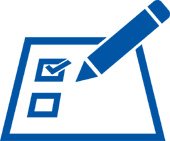
Alternative assessment, which is authentic by nature, has been described as an alternative to standardized testing and all of the problems found with such testing. Garcia and Pearson (1994) equate alternative assessment with performance assessment, authentic assessment, portfolio assessment, informal assessment, situated (or contextualized) assessment, and assessment by exhibition.
According to Fulcher (1996) and Lazaraton (1996, as cited in Brindley, 1998), qualitative analyses of authentic language use are required to cast more light on the nature of the language skills involved in performing the communicative functions described in outcome statements.
Among various manifestations of authentic or alternative assessment are self, peer, and portfolio assessment. The significance of these dimensions of assessment is so high that Brown (2001) argues:
Successful learners extend the learning process well beyond the classroom and the presence of a teacher or tutor, autonomously mastering the art of self-assessment. And where peers are available to render assessment, why not take advantage of such additional input? (p. 415).
Portfolios are appropriate vehicles for metacognitive awareness. Such metacognitive awareness is basic to further reading. Furthermore, portfolio assessment involves its users in larger issues of teaching, learning, intuitional goals and objectives, and individualization in language learning.
Weigle (2002) and Hamp-Lyons (1991, as cited in Hughes, 2003) believe that a collection of papers on the assessment of writing in academic contexts together with the use of computers as raters can help language teachers and learners a lot to get closer to alternative assessment.

According to Genesee and Upshur (1996, as cited in Carter & Nunan, 2001), a portfolio is “a purposeful collection of students’ work that demonstrates …their efforts, progress and achievements in given areas” (p. 99). As Brown (2004, p. 256) has stated, portfolios include materials such as:
- essays and compositions in drafts and final forms;
- reports, project outlines;
- poetry and creative prose;
- artwork, photos, newspaper or magazine clippings;
- audio and/or video recordings of presentations, demonstrations, etc.;
- journals, diaries, and other personal reflections;
- tests, test scores, and written homework exercises;
- notes on lectures, and;
- self and peer-assessments—comments, evaluations, and checklists.
A developmental scheme for considering the nature and purpose of portfolios, using the acronym CRADLE to designate six possible attributes of a portfolio, namely collection, reflection, assessing, documenting, linking, and evaluation is suggested by many scholars. The advantages of engaging students in portfolio development have been extolled in a number of sources (Brown & Hudson, 1998; Genesee & Upshur, 1996; O’Malley & Valdez Pierce, 1996; Weigle, 2002). A synthesis of those characteristics gives us a number of potential benefits. Portfolios:
- foster intrinsic motivation, responsibility, and ownership,
- promote student-teacher interaction with the teacher as facilitator,
- individualize learning and celebrate the uniqueness of each student,
- provide tangible evidence of a student’s work,
- facilitate critical thinking, self-assessment, and revision processes,
- offer opportunities for collaborative work with peers, and
- permit assessment of multiple dimensions of language learning.
Moss’s (1994, as cited in Brindley, 1998) comments are a timely reminder of the need to collect assessment information from a variety of sources and strengthen the case for using procedures such as portfolio assessment which present a broad range of learner performances.
Research has shown (Brown & Hudson, 1998) a number of advantages of self and peer-assessment: speed, direct involvement of the students, the encouragement of autonomy, and increased motivation because of self-involvement in the process of learning. Of course, the disadvantages of subjectivity looms large, and must be considered while proposing to involve students in self and peer-assessment.
According to Baker (1989), in group assessment, the performances of a number of candidates are assessed during an extended role-play. In this response, a useful technique is the tribunal simulation in which half the group are, for example, members of a board which must make some kind of decision about allocating low-rent housing to deserving families. The other half of the group plays the families applying for the housing.
And finally, the significance of journal writing as a prominent role in educational model that emphasizes the importance of self-reflection is closely investigated. Brown (2004) states that “a journal is a log or account of one’s thoughts, feelings, reactions, assessments, ideas or progress toward goals, usually written with little attention to structure, form or correctness” (p. 260).

In this response, as a general rule, the students are actively involved in brainstorming, free writing or non-stop writing based on their stream of consciousness. Meanwhile, it should be noted that the students’ errors must NOT be critically corrected. Fortunately, models of journal use in educational practice have sought to tighten up this style of journal in order to give them some focus. The result is the emergence of a number of overlapping categories or purposes in journal writing, such as the following:
- language-learning logs
- grammar journals
- responses to readings
- strategies-based learning logs
- self-assessment reflections
- diaries of attitudes, feelings, and other affective factors
- accumulation logs
Most classroom-orientated journals are what have now come to be known as dialogue journals. They lucidly signify an interaction between a reader (the teacher) and the student through dialogue or responses (Brown, 2004). In general, dialogue journals are requested at regular intervals, perhaps weekly or biweekly. Brown (2004) further declares that “Through dialogue journals, teachers can become better acquainted with their students, in terms of both their learning progress and their affective states, and thus become better equipped to meet students’ individual needs” (p. 260).
He (2004) also adds practice in the mechanics of writing, using writing as a “thinking” process, individualization, communication with the teacher, and a unique opportunity for the teacher to offer various kinds of feedback to the list of benefits derived from dialogue journals.

However, among all of the advantages attributed to dialogue journals, they are often criticized for being too free or subjective without any fixed criterion. Brown (2004, pp. 262 – 264) has offered the following tips to seek feasible solutions to the raised problem:
- Sensitively introduce students to the concept of journal writing.
- State the objective(s) of the journal.
- Give guidelines on what kinds of topics to include.
- Carefully specify the criteria for assessing or grading journals.
- Provide optimal feedback in your responses.
- Designate appropriate time frames and schedules for review.
- Provide formative, washback-giving final comments.
Shohamy and Reves (1985) criticize authentic assessment by attributing two problems to it: (1) the difficulty of applying appropriate psychometric measures, caused by the complexity of tapping the whole construct of authentic language; and (2) the large number of test variables which interfere with the authenticity of the language produced and reduce it to authentic test language.
According to Brown and Hudson (2002), because of the ongoing nature of authentic assessment throughout the term of instruction, this type of assessment tends to be particularly appropriate for assessing learning processes. However, it should be added that authentic or alternative assessment has the disadvantages of being relatively difficult to create and structure, and involving subjective scoring, if they are scored at all. Brown and Hudson (1998) believe that the assessment procedures, what they cover, and how they are scored should be developed in consultation between the students and teachers.
On the other hand, as Rose (1994) and Rose and One (1995, as cited in McNamara & Roever, 2006) have found, participants might feel forced to respond in a DCT, whereas in reality, they would prefer to remain silent. In real-world situations, they also have other means at their disposal; for instance, instead of refusing directly, they may superficially comply with a request, but in fact, perform whatever is requested less than enthusiastically. In short, in such tests, it is not practically possible to allow test takers to opt out because such opting out would be indistinguishable from simply not knowing the correct response.
That’s why for tests of language abilities, many theorists have recently argued that assessment tasks need to somehow capture ore recreate the essence of language use, urging that authenticity should be a fundamental criterion for the validity of tasks that aim to evaluate how well people can really communicate in a language (Backman & Palmer, 1996; Lewkowicz, 2000; Spence-Brown, 2001, as cited in Fulcher & Davidson, 2007).
Methodology
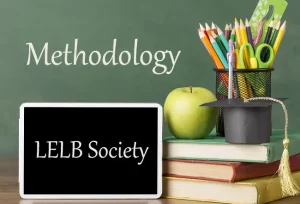
To investigate the study, the researcher chose a qualitative approach that was based on Triangulation (i.e. observations, interviews, and documentations). The employment of a qualitative or interpretative methodology was due to the fact that a naturalistic grounded theory research design was thought of as the finest procedure to collect and analyze the data.
On the other hand, as a branch of qualitative research, on the basis of the requirements, a Classroom-centered Research (CCR) approach was utilized to investigate the phenomenon under study over an extended period of time, i.e. about three months in length in an attempt to augment the credibility and dependability of data collection and analysis.
Furthermore, the utilization of Triangulation with its own three sub-divisions was another reason contributing to more credibility because various sources of data collection were employed. As an observer, in an attempt to discard formality and alienation, the investigator did not make a border between the participants and himself. In fact, he himself took part in all of the course activities; in consequence, the researcher can be regarded as a participatory observer, too.
Research design and approach
In this research, to investigate the phenomenon under study, a theme-based approach was put to use to instruct the approximately 100 participants in an extra-curricular course under the title “Learn English to Live Better! (LELB)”. As it is clear by its name, in this theme-based approach, all of the four skills were integrated in order to make a whole and apart from language proficiency, another equal value was placed upon some psychological and intriguing subject matter, namely replacing pessimism with optimism, boosting self-confidence and self-esteem, how to say good-bye to jealousy, etc.

The curriculum that was developed and then modified over the passage of the course was a sort of Negotiated Curriculum, i.e. the participants were heartened to reveal their contributions in response to the syllabus and the educational module. Furthermore, having been developed, it was constantly in a state of flux. That is, we made as many modifications as needed to the curriculum in an attempt to satisfy the participants’ needs and wants.
Another characteristic attributed to the research design of the study is that the curriculum was not book-centered at all. That is to say, the researcher never overemphasized the completion of books as a necessity. Accordingly, an equal value was put on both of the process and product and it was preferred that the participants could understand the assigned materials in depth.
Self-discovery, cooperative learning, and whole-language learning were three basic criteria upon which the research methodology was founded in the hope that the participants could authentically assess themselves, thanks to peer-assessment, self-assessment, learning logs, and most importantly, portfolio-assessment.
Findings and results
In the light of the study, it was discovered that traditional assessment does fail to help us truly assess the students’ competency. Therefore, the application of product-oriented approaches, for instance, final exams and entrance exams in which the students’ final performance is considered the bare touchstone of assessment, is indisputably under question. Instead, it is imperative that we should make use of an amalgamation of process-oriented and product-oriented approaches to get closer to a more reliable type of assessment.

While we are talking about it, the researcher has created a simile between the application of authentic/alternative assessment and EQ. To be more precise, standardized achievement tests, including IQ tests contribute only about 20 percent to the factors that determine success. A full 80 percent comes from factors germane to emotional intelligence.
This relativity can more or less be traced between authentic/alternative assessment and traditional assessment. In other words, as IQ (compared with EQ) fails to account for one’s success, traditional assessment cannot justify and elicit the learner’s genuine and true competency, either.
In point of fact, authentic or alternative assessment and post-method are one and the same in the sense that as post-method is an alternative to methods, rather than an alternative method, alternative assessment is also unrestricted and free to employ any practical procedure to justify the learners’ actual competency.
Alternative assessment for English learners provides a menu of possibilities, rather than any one single method for assessment. Thus, student growth can be more reliably assessed because information from various sources is included in the process. For optimal learning to take place, students in the classroom must have the freedom to experiment and try out their own hypotheses about language without feeling that their overall competence is being judged in terms of those trials and errors. As a result, authentic/alternative assessment, which is pretty closer to subconscious evaluation, is more viable and functional.

Likewise, with the intention of compounding meaningful and genuine essence to our teaching; and as a result, ruling out mechanical education, the learners ought to assume some responsibilities. That is, they should not be barely consumers, but rather experiencers, risk takers and producers as well. In this manner, their passive stance is replaced by an active and erudite involvement in the process of learning.
The learners develop a great penchant to forge a strong link between what happens in the classroom and what takes place outside the class. As a matter of fact, real-life situations are operationalized in language courses to make language learning more natural. In fact, education is most effective when it is experience-centered, i.e. when it makes direct reference to the learners’ authentic needs. Students are motivated by their personal involvement. Teachers are co-learners, asking questions of the students, who are the experts on their own lives. This is completely in line with participatory approach.
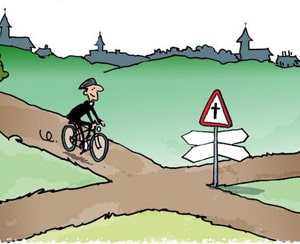
As a matter of fact, to illustrate the distinction between process-oriented and product-oriented approaches, the conductor of the study equates the product-oriented approach with traveling by plane in which the passenger is not aware of the process. He may fall asleep during the flight and then be awakened by the stewardess’s voice announcing the arrival at the destination.
In this manner, the passenger, (not the experiencer) is taken to the journey’s end while he has a passive role. He/she cannot take pleasure or even feel pain in the process of the journey. Even though they strive to do so, this permission is not given to them as it is integral to this mechanical and spiritless fashion of journey.
On the contrary, the learner educated on the ground of the process-oriented approach is likened to the same passenger with this distinction that he is an experiencer as well. This is due to the fact that he goes on the same trip but by bike. In consequence, during the journey, He/she MUST be actively involved and circumspect enough to navigate the route and be in charge of every event occurring to him/her. In so doing, our passenger or experiencer ought to coach him appropriately in preparation for the inevitable ups and downs of the path. Consequently, the bike-rider is responsively preoccupied with the pleasure and agony of the voyage. The outcome is that his muscles strengthen and his forbearance is boosted tremendously.
Moreover, the active rider can, in the real sense of the word, enjoy the trip. When he arrives at a fascinating scene and longs for a sojourn, he can temporarily call a halt to the excursion and get some rest in the heavenly landscape. What’s more, although he is required to make a painstaking attempt to cycle to the destination, the intensity of the quantity and quality of the pleasure he takes at the time of the arrival is never ever comparable to the pain he feels during the trip.
In point of fact, with the purpose of fulfilling this achievement, we can multiply the sole number of the single rater, that is, the teacher, by copious numbers of raters, i.e. the participants themselves. Consequently, the amount of subjectivity and discrimination that are unavoidable in case there is solely one rater descends to a pretty noticeable extent.
Motivated learners, individually or en masse, can train themselves systematically in ways of assessing and evaluating their own learning progress in terms of identifying their strengths and weaknesses. In this regard, portfolio writing and learning logs are substantially significant because when the learners are encouraged to compose journals regularly and when they note that their journals or logs are precisely analyzed and considered by the teacher, they take an abundance of heed of writing their logs, and in this manner, they strive to level with the teacher and other participants for the good of themselves.

Thus, to put the theory into practice, by taking some criteria into consideration, we can appeal to our learners to perform self-assessment. Even more idealistically speaking but not far from reality, we can operationalize peer-assessment techniques so that the learners get more enthusiastic about establishing and maintaining required amity and solidarity among themselves to work en masse to assess one another.
As it is self-evident, the learners are informed of how to learn to learn. In fact, they will develop more autonomy and intrinsic motivation in their learning. In so doing, they gain more control over their own classes. What’s more, teacher’s domination and ascendancy are reduced noticeably; and as a result, we will have a bilateral class in which ‘learner-centeredness’ is practiced tremendously.
Another eye-catching function of authentic assessment is the application of learning log and portfolio-writing. As briefly mentioned above, more generally speaking, portfolio assessment is a qualitative approach to program evaluation which calls for a cooperative maintenance of a set of files on the instructional program. If the learners are encouraged to keep a diary of their learning by the aid of learning logs and portfolios, they can increase their awareness and metacognition in association with their learning.
In so doing, the learners form optimum self-responsibility corresponding with their course. As a matter of fact, they are required to develop erudite contributions to the course and then profoundly reflect upon their own contributions with the help of metacognitive strategies. As a result, retrospective learning is enhanced noticeably.

The other benefit derived from portfolio writing as an indispensable manifestation of authentic or alternative assessment is a priceless and unique source of feedback that is bestowed upon the teacher. Therefore, it more nearly ensures that needed reforms will take place throughout the course. According to Mousavi (1999), by implementing portfolio assessment, “very helpful information can be gathered and shared by teachers and administrators with no formal training in research design or statistics. Formal tests or questionnaires are not needed” (p. 277).
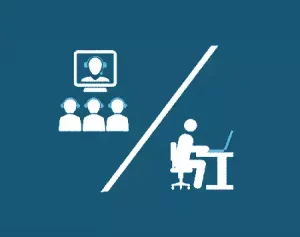
What’s more, portfolio assessment promotes cooperation rather than competition among teachers because, to be effective, this method requires great willingness on the part of the teachers to share ideas and to note problems as well as successes. In so doing, the instructors can establish educational forums comparing and contrasting their discoveries derived from their learners’ portfolios or even their own ones. As Mousavi (1999) has pointed out, discoveries and findings can be conserved for future applications in other classes.
In short, as discussed above, by considering the problems that we encounter these days in many educational systems, replacing traditional assessment, which is regrettably dominant nowadays, with revolutionary authentic or alternative assessment along with its unique features seems to be imperative in the hope that we could bridge the educational gaps that are getting wider and wider.
Conclusion
As discussed in the Statement of the problem section, it is imperative that we should move forward from traditional to authentic/alternative assessment to seek apt solutions to the existing problems, namely mechanical learning, teacher-centeredness, student enslavement, lack of intrinsic motivation and bona fide participation, competitive learning, spiritless and uninteresting education and so on and so forth.
By dint of alternative assessment, the learners are encouraged to have cooperation with each other (especially in peer-assessment), so cooperative learning is practiced in the classroom. They develop an additional propensity to actively take part in the class since they have faith in the authenticity and fruitfulness of the tasks.
As the learners increase their class participation by assuming various responsibilities, particularly in terms of self-assessment, portfolio assessment, and dialogue journals, slowly but surely, they tend to employ more metacognitive strategies and knowledge by being quite reflective and pensive. That is to say, authentic assessment does make excellent way for reflective/retrospective learning and also teaching.
When these highly-motivated learners gain more independency and control of their activities, in the course of time, they acquire and internalize an outstanding amount of autonomy in language learning because on many occasions, they are inspired to learn how to learn through actual experimentation.
References
- Bachman, L. F. (1990). Fundamental considerations in language testing. Oxford: Oxford University Press.
- Baker, D. (1989). Language testing: A critical survey and practical guide. London: Edward Arnold Publication.
- Best, J. W., & Kahn, J. V. (2006). Research in education. Boston, MA: Pearson Education Inc.
- Brindley, G. (1989). Assessing achievement in the learner-centered curriculum. Sydney: Macquarie University.
- Brindley, G. (1998). Outcomes-based assessment and reporting in language learning programmes: A review of the issues. Language Testing, 15(1), 45-85. doi:10.1177/026553229801500103
- Brown, H. D. (2001). Teaching by principles: An interactive approach to language pedagogy. New York: Longman, Inc.
- Brown, H. D. (2004). Language assessment: Principles and classroom practices. New York: Pearson Education, Inc.
- Brown, J. D., & Hudson, T. (1998). The alternatives in language assessment. TESOL Quarterly, 32(4), 653-675. doi:10.2307/3587999
- Brown, J. D., & Hudson, T. (2002). Criterion-referenced language testing. Cambridge: Cambridge University Press.
- Carter, R. & Nunan, D. (2001). The Cambridge guide to teaching English to speakers of other languages. Cambridge: Cambridge University Press.
- Fulcher, G., & Davidson, F. (2007). Language testing and assessment: An advanced resource book. Oxen: Routledge.
- Hughes, A. (2003). Testing for language teachers (2nd Ed.). Cambridge: Cambridge University Press.
- Madsen, H. S. (1983). Techniques in testing. Oxford: Oxford University Press.
- McNamara, T., & Roever, C. (2006). Language testing: The social dimension. Malden, MA: Blackwell Publishing Group.
- Mousavi, S. A. (1999). A dictionary of language testing. Tehran: Rahnama Publications.
- Nunan, D. (2001). Second language teaching and learning. Boston, Massachusetts BM: Heinle and Heinle Publishers.
- Peacock, M. (1997). The effect of authentic materials on the motivation of EFL learners. ELT Journal, 51(2), 144-156. doi:10.1093/elt/51.2.144
- Richards, J. C. & Renandya, W. A. (2002). Methodology in language teaching: An anthology of current practice. Cambridge: Cambridge University Press.
- Richards, J. C. & Schmidt, R. (2002). Longman dictionary of language teaching and applied linguistics. Edinburg: Pearson Education Limited.
- Rivers, W. M. (1981). Teaching foreign-language skills. Chicago: The University of Chicago Press.
- Shohamy, E., & Reves, T. (1985). Authentic language tests: Where from and where to? Language Testing, 2(1), 49-59. doi:10.1177/026553228500200106
- Weir, C. J. (2005). Language testing and validation: An evidence-based approach. London: Antony Rowe, Ltd.
How to cite this article in APA Style?
Hariri Asl, M. H. (2023). Authentic assessment for English language learners. LELB Society, https://lelb.net/authentic-assessment-for-english-language-learners/

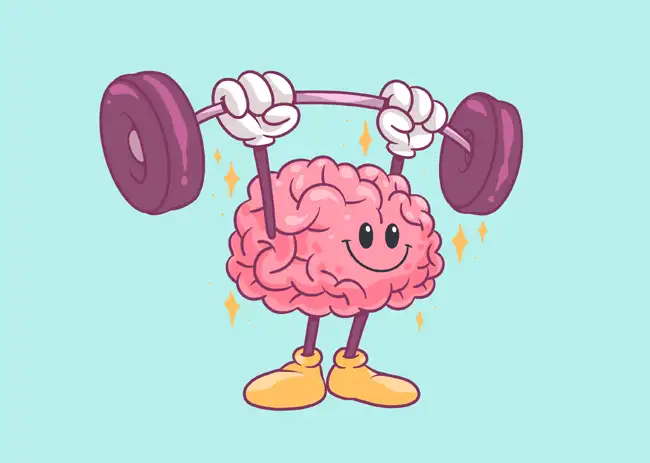

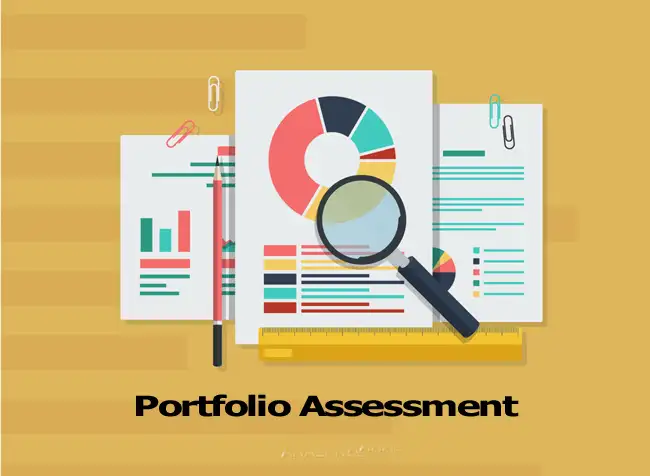
We respond to all comments immediately. View the 30 newest comments and new topics in forums.